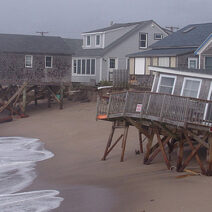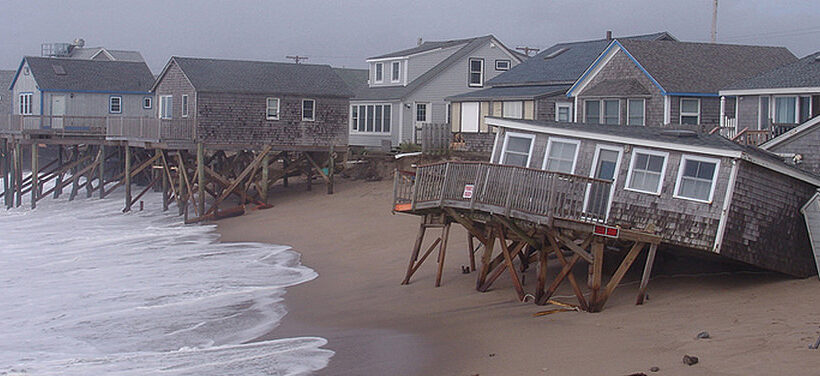As the world grapples with the palpable effects of climate change, coastal communities find themselves at a precarious juncture. Flooding, exacerbated by global warming, looms larger than ever, threatening not just ecosystems but the very fabric of human settlements along coastlines. With rising sea levels and increasingly violent weather patterns, one has to ponder: what happens when the land meets the inexorable sea and not on an idyllic day, but during a tempest? This question encapsulates a significant challenge faced by millions globally.
To comprehend the flooding threat induced by global warming, it is essential to first unravel the interconnected phenomena contributing to this crisis. One of the most pressing factors is the melting of polar ice sheets and glaciers. These colossal bodies of ice, which have taken millennia to form, are dissolving at an alarming rate. According to various scientific reports, since the late 20th century, the Antarctic and Greenland ice sheets have lost mass—adding to global sea levels. This melting is not a distant threat; it is happening now, with implications cascading like dominos down to coastal cities.
In tandem with melting ice, thermal expansion of seawater due to increasing temperatures plays a pivotal role. Water expands as it warms, and since the ocean absorbs a significant portion of the heat from climate change, this expansion contributes to rising sea levels. The result is an insidious creep of seawater infiltrating into areas once deemed safe and habitable, igniting concerns over the reliability of land currently occupied by households, businesses, and vital infrastructure.
The consequences of these changes are not uniform; some regions face existential risk, while others may experience more subtle shifts. Low-lying areas, particularly in Southeast Asia, the Gulf Coast of the United States, and parts of Europe, are on the frontline. These regions are increasingly susceptible to “nuisance flooding,” which occurs even on clear days due to elevated sea levels. It challenges the daily lives of residents and raises the stakes for local economies, as businesses suffer disruptions from the encroaching waters.
Meanwhile, extreme weather events, fueled by climate change, are intensifying. Hurricanes, typhoons, and nor’easters carry not just formidable winds but also vast amounts of rain and storm surges. The devastation they leave in their wake is often catastrophic, with flooding becoming a grim hallmark of these meteorological beasts. Communities are left grappling with damaged infrastructure, contaminated water supplies, and long recovery periods. Many residents face displacement, with some forced to abandon their homes entirely.
Consider New Orleans, a city that has already borne the brunt of catastrophic flooding. After Hurricane Katrina, massive efforts were made to bolster levees and enhance the city’s flood defenses. But the threat remains acute. As sea levels continue to rise, the specter of another disaster looms. Will cities like New Orleans adapt sufficiently to avoid falling into the abyss created by nature’s fury? The uncertainty is troubling.
The interplay between flooding and human activity compounds these challenges further. Urbanization along coastlines has led to both habitat disruption and increased runoff, exacerbating flooding risks. Impermeable surfaces such as concrete prevent water from soaking into the ground, leading to increased surface runoff during downpours. As coastal populations swell, the demand for housing, amenities, and infrastructure intensifies, often at the expense of natural barriers that safeguard against flooding.
Adaptation strategies must become a priority. Coastal communities need to embrace innovative approaches to mitigate the impending threats they face. Enhancing natural defenses such as wetlands, mangroves, and coral reefs can provide critical buffers against storm surges and flooding. These ecosystems, often overlooked, play an essential role in absorbing wave energy and stabilizing shorelines. Protecting and restoring them should be a unified goal among local governments and NGOs alike.
Furthermore, the notion of managed retreat—a controversial yet necessary strategy—may need to be explored. For communities at high risk, this would involve a strategic withdrawal from areas that are increasingly vulnerable to flooding. Such a move, albeit difficult, would mitigate risks and allow populations to move to safer locales. However, it demands a robust and well-planned approach to resettle individuals, balancing social equity with environmental necessity.
In parallel, investment in resilient infrastructure is critical. It is no longer enough to build roads and buildings; they must be fortified against the realities of climate change. This includes elevating structures, enhancing drainage systems, and employing flood-resistant designs. These measures not only protect the built environment but also instill confidence in communities and bolster economic vitality in the face of uncertainty.
Education and community engagement are paramount as well. Residents must be aware of the risks they face and the strategies available for companionship in facing these challenges. Increased public consciousness can lead to better preparedness, resulting in communities that are not just survivors but resilient, adaptive entities ready to confront whatever nature throws their way.
In conclusion, flooding as a consequence of global warming is not merely a distant phenomenon; it is an urgent and immediate threat. Coastal communities must prioritize adaptive strategies that encompass natural defenses, managed retreat, resilient infrastructure, and community engagement. The interplay of these elements will help to mitigate flooding risks and safeguard the lives and livelihoods of individuals situated on the frontline of climate change. Will coastal communities rise to meet this challenge, or will they be engulfed by the very seas they once took for granted?






